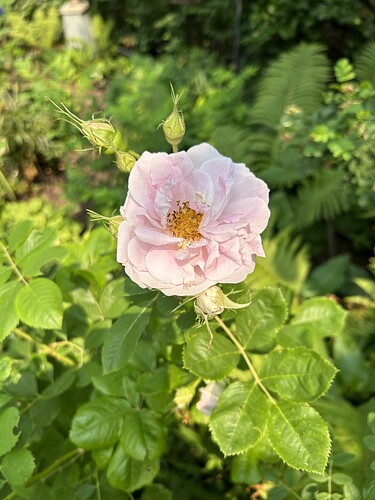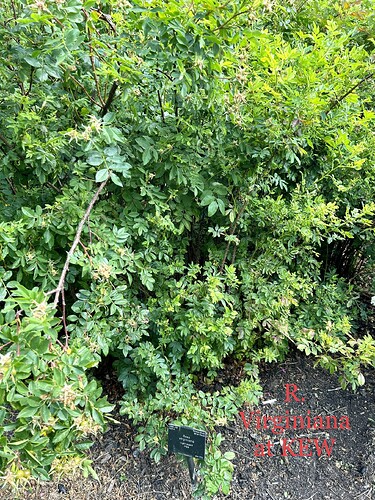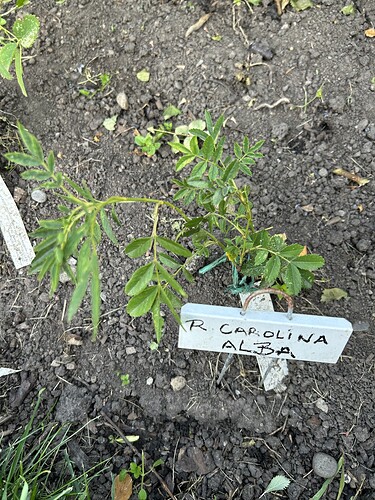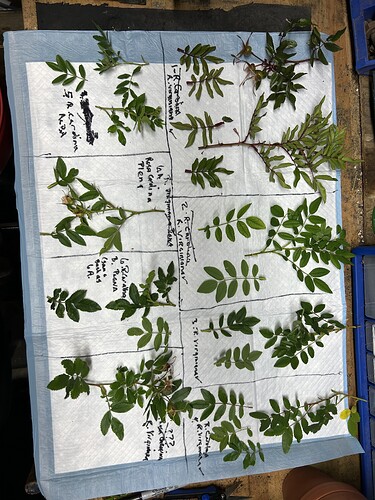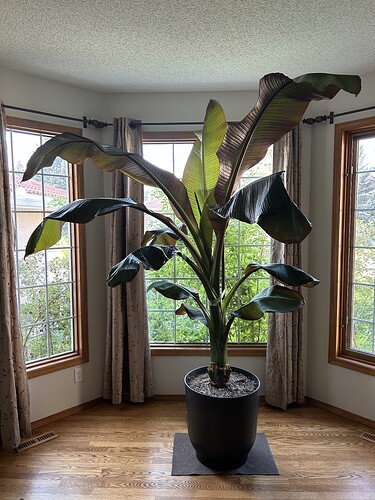Many thanks for sharing,RikuHelin! What an interesting beauty. In my experience, the hereditary predisposition to balling is a recessive trait, so that very often it is no longer found consistently in a new F1.
Txs. Good to know. l tend to ignore roses in my garden for crossing whose buds can barely to not tolerate “wetting” (mostly species).
This character l find bizarre as l consider my climate to be to the dry side due to being in a rain shadow of the eastern slope of the Rocky mountains. Basically grassland around here but more intense further south to Montana border.
And interestingly a consistent example, Banshee (Pickering name change via Stefan), never gave me a real bloom in 10-15 years until by “weather fluke” (fire storm dryness???) got couple l deem perfect.
Oddly enough, I have usually gotten at least a fair number of good flowers each year from my Banshee clones here in my far more humid, warm environment (usually mixed with some buds that ball and fail in the usual way, of course). I can’t quite say whether the opening-or-not pattern seems related directly to weather. Maybe it’s a matter of them being sufficiently fertilized and at peak vigor to provide those lucky buds with the extra “oomph” they need; smaller ones tend to have more trouble. They are always beautifully scented when they do open well.
Flower balling issues aside, I think this is one of the most adaptable and healthy of all OGRs, capable of growing from at least USDA zones 4a through 9, and apparently adaptable to a wide soil pH range. One of my clones came misidentified from a nursery in Victoria, BC; another one came correctly identified as Banshee from a small nursery in southern Louisiana. The Banshees can grow equally well and flower equally badly across a surprisingly large geographic and climatic area!
Stefan
Hi Stefan,
Agree pleasant bloom, and photo from its location in part of back colder garden shaded by Dolgo (sic) apple.
Plant is over 15 years old small and always buds. Nothing seems to be able to cause a demise … but winter cane damage … been surprised by its toughness … just wish it would bloom to open more often. It gets miracle grow dosing once a growing season and in the spring.
The “white” Minette (doubt it) of another supplier does the same thing. However in sunnier front and after a good winter is large (relatively speaking). Also get the odd bloom - younger rose.
Found Kew “monster” R Virginiana. No R carolina to compare size.
l guess curiosity kicked in and l took photo.
… looking at … hmmmm
Hi RikuHelin! Thank you so much for your help and remembering of the R. carolina matter at Kew. What an opulent R. virginiana! Surely there will be another opportunity to track down R. carolina for some comparison work at some point. We should just continue to keep our eyes vigilant.
We’ve a great deal of Canina subspecies that are hard to distinguish. Researchers in some studies used the stipul, hip-shape and glands or hairs on the hip and especially the average diameter of the orificum (tiny hole on top of the hip). The hip apparently is a very good indicator to separate subspecies, but it often comes to differences of millimeters or less.
Hi Roseus,
Here is another example in my garden, but different, and very young, R. Carolina Alba. I received from a well known Canadian cold zone hybridizer “Ami”.
Leaves follow 7 max benchmark so far. Made it through one winter.
It is unlikely this rose came from the same source l used, as never seen it offered by my vendor of hardies.
There’s a good chance that is the same one that Hortico was offering some years back; it may have had other Canadian sources, of course. It might very well be the most common clone going around under that name, not that it is all that common. Its petals are pure white without any trace of pink. I briefly grew a form offered by Prairie Moon Nursery back in 2011, which was a very, very pale pink form of a strikingly different ecotype that much more closely resembled R. arkansana, having relatively thin, dull, pale green leaves. That one wasn’t very happy here and expired within a short period of time.
With fall fast approaching went out and re- jigged the names of my 7 bushes.
Photo the result.
Old x’ed out new in, and one question mark.
Based on what I can see of stipules and prickles, I’d say that #s 1 and 7(?) are R. virginiana, and the rest are probably all actually R. carolina, which is pretty variable but generally has narrower stipules plus smaller/weaker and straighter prickles. #7 is based mostly on stipules because I don’t see any prickles; does it have them? Lucky you if it doesn’t!
Stefan
Hi Stefan
Thanks for your cut on ids. Good to get informed opinions.
Unfortunately #7 does have paired prickles below the stipules (photo).
To my eyes - have advantage of physical samples to examine - 80% of the stipules follow the trend of being 3/4 of the distance from cane - leaf node to first leaflet pair. Width flaring at 1st leaf end point and cane to leaf stipule width ratio appears (2-3x) same to my eyes.
Have a challenge noting any physical geometry difference on stipules.
With all due respect to Don expertise, it appears the red cane and leaflet “petiole”, and individual leaf “petiolule” on the pinnately compound leaves is restricted to the “sunny side” on canes as green on shadow side (learned new leaf stem terms so like to over use for the moment).
Call it a sun tan, not burn.
That specific bush is a giant (relative) and in all day sun. The red color (burnt umber or sienna?) and 9 leaf is a strong differentiator. Only one of the 7, have l noticed this trait combination (9 + red) - 4 others in same general location but significantly smaller bushes and green to yellowish green (fall coming?). But 9 leaves dominates on 2 if them.
The major consistency (#1) of the new jigged name “R. virginiana” is the dominance of “9” leaflets, (# 1 at least 98%) while R. carolina is dominantly 7’s and less.
I am starting to entertain this rosa occurs and occupies a bizarre continuum consisting of subtle differences.
And just have to throw in this random photo of my “not a rose or a tree or typical banana bush”, its an of ensete maurelii (Ethiopian “banana tree”).
The only focal point of a sparsely furnished main room in house. Grown about 30% in height since obtained.
Seems to be a outdoor garden staple, plus normal banana “trees”, in warmer UK far west country gardens for those wanting tropical feel. Yes l got the must have need from BBC Gardeners world - monty gone green and climate change extremes and stopping bringing in his bananas and his cana? lillies. Me? indoor plants / trees back in demand.
At -25 C in Jan it will do the trick indoors with gingers and hibiscus until tropics settle down.
